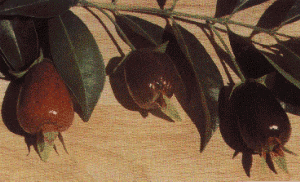Sunset®: 24-27
USDA: 9-11
Frost Tolerance: Protect young trees. When established, is hardy to 20 degrees.
Sun Exposure: Full sun.
Origin: Brazil
Growth Habits: Evergreen shrub to 6 feet high
Watering Needs: Fairly good drought tolerance.
Propagation: Generally propagated by seed. Sometimes by cleft or veneer grafting, or shield budding.
The Cherry of the Rio Grande is a shrub which commonly grows to about 15 feet. It is very attractive, especially when in bloom. The smooth, glossy, dark green leaves are narrow elliptic, 21/2 to 3 inches long and are borne on short, grooved petioles. The fruit contains up to 2 white, rounded seeds.

Cherry of the Rio Grande
(Eugenia aggregata)
Photo by Ben Poirier
Courtesy of CRFG Inc.
Blooming Habits:
In Florida, the cherry of the Rio Grande starts blooming in the first part of March. The flowering season lasts several months, occasionally until May. The flowers are white.
Fruiting Habits:
The fruit ripens on the bush 3 weeks after the blossom. It is red to deep purple about 1 inch diameter with a sweet cherry taste. The fruit can also be used for jelly, jam or juice.
Culture:
Cherries of the Rio Grande are easy to grow, requiring relatively little maintenance for the growth of healthy, productive plants. Fruit size and quality depends to a large extent on proper nourishment and an adequate water supply at the time of fruit development. When first planted, they need a complete fertilizer in a 1-1-1 ratio, such as 6-6-6, that also contains magnesium. Start with no more than 1/4 pound at monthly or bi-monthly intervals, increasing the rates commensurate with growth. If iron deficiency in calcareous soils is a problem, this element should be applied as Sequestrene 138, injected or drenched into the soil when needed. Nutritional sprays to supply other minor elements should also be applied as needed. After the tree has matured, a fertilizer such as 8-3-9 with 5% MgO is more appropriate.
The plants should be supplied with adequate water at all times but especially during bloom and fruit development. The cherry of the Rio Grande has fairly good drought tolerance. The cherry of the Rio Grande requires very little pruning to make an attractive tree and it is seldom pruned to make a hedge.
Propagation:
This species is generally propagated by seeds. Seeds usually germinate in less than a month, but can take 5 years to produce. The better selections can be veneer grafted, or reproduced by cuttings, although grafting has a low success rate.
Links:
CRFG Eugenia aggregata link.
University of Florida: Selected Eugenia Species.
Desert-Tropicals is dedicated to provide gardening advice, gardening ideas, and information about flower of all kind for landscape and collections.We try to check carefully the identification of the plants on the illustrations as well as the other information from the page, but occasionally errors do occur. if you notice anything that needs to be changed please contact us.Thanks.
© 1998-2020 Philippe Faucon, All Rights Reserved.
